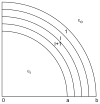Image Charge Methods for a Three-Dielectric-Layer Hybrid Solvation Model of Biomolecules
- PMID: 20556225
- PMCID: PMC2885744
- DOI: 10.4208/cicp.2009.v6.p955
Image Charge Methods for a Three-Dielectric-Layer Hybrid Solvation Model of Biomolecules
Abstract
This paper introduces a three dielectric layer hybrid solvation model for treating electrostatic interactions of biomolecules in solvents using the Poisson-Boltzmann equation. In this model, an interior spherical cavity will contain the solute and some explicit solvent molecules, and an intermediate buffer layer and an exterior layer contain the bulk solvent. A special dielectric permittivity profile is used to achieve a continuous dielectric transition from the interior cavity to the exterior layer. The selection of this special profile using a harmonic interpolation allows an analytical solution of the model by generalizing the classical Kirkwood series expansion. Discrete image charges are used to speed up calculations for the electrostatic potential within the interior and buffer layer regions. Semi-analytical and least squares methods are used to construct an accurate discrete image approximation for the reaction field due to solvent with or without salt effects. In particular, the image charges obtained by the least squares method provide accurate approximations to the reaction field independent of the ionic concentration of the solvent. Numerical results are presented to validate the accuracy and effectiveness of the image charge methods.
Figures










Similar articles
-
Three-dielectric-layer hybrid solvation model with spheroidal cavities in biomolecular simulations.Phys Rev E Stat Nonlin Soft Matter Phys. 2010 Jan;81(1 Pt 2):016701. doi: 10.1103/PhysRevE.81.016701. Epub 2010 Jan 5. Phys Rev E Stat Nonlin Soft Matter Phys. 2010. PMID: 20365496
-
A Fast and Robust Poisson-Boltzmann Solver Based on Adaptive Cartesian Grids.J Chem Theory Comput. 2011 May 10;7(5):1524-1540. doi: 10.1021/ct1006983. J Chem Theory Comput. 2011. PMID: 21984876 Free PMC article.
-
Universal solvation model based on solute electron density and on a continuum model of the solvent defined by the bulk dielectric constant and atomic surface tensions.J Phys Chem B. 2009 May 7;113(18):6378-96. doi: 10.1021/jp810292n. J Phys Chem B. 2009. PMID: 19366259
-
An image-based reaction field method for electrostatic interactions in molecular dynamics simulations of aqueous solutions.J Chem Phys. 2009 Oct 21;131(15):154103. doi: 10.1063/1.3245232. J Chem Phys. 2009. PMID: 20568843 Free PMC article.
-
Protein electrostatics: a review of the equations and methods used to model electrostatic equations in biomolecules--applications in biotechnology.Biotechnol Annu Rev. 2003;9:315-95. doi: 10.1016/s1387-2656(03)09010-0. Biotechnol Annu Rev. 2003. PMID: 14650935 Review.
Cited by
-
A smoothly decoupled particle interface: new methods for coupling explicit and implicit solvent.J Chem Phys. 2011 Jun 7;134(21):214103. doi: 10.1063/1.3595262. J Chem Phys. 2011. PMID: 21663340 Free PMC article.
-
A robust numerical method for self-polarization energy of spherical quantum dots with finite confinement barriers.Comput Phys Commun. 2010 Apr 1;181(4):787. doi: 10.1016/j.cpc.2009.12.011. Comput Phys Commun. 2010. PMID: 20161693 Free PMC article.
-
Stochasticity in materials structure, properties, and processing-A review.Appl Phys Rev. 2018 Mar;5(1):011302. doi: 10.1063/1.4998144. Epub 2018 Mar 7. Appl Phys Rev. 2018. PMID: 30397419 Free PMC article.
-
Fast Analytical Methods for Macroscopic Electrostatic Models in Biomolecular Simulations.SIAM Rev Soc Ind Appl Math. 2011 Nov 7;53(4):683-720. doi: 10.1137/090774288. SIAM Rev Soc Ind Appl Math. 2011. PMID: 23745011 Free PMC article.
-
Image Charge Method for Reaction Fields in a Hybrid Ion-Channel Model.Commun Comput Phys. 2011;9(4):1056-1070. doi: 10.4208/cicp.160410.200910a. Epub 2010 Nov 10. Commun Comput Phys. 2011. PMID: 23504509 Free PMC article.
References
-
- Abagyan R, Totrov M. Biased probability Monte Carlo conformational searches and electrostatic calculations for peptides and proteins. J Mol Biol. 1994;235:983–1002. - PubMed
-
- Abramowitz M, Stegun IA. Handbook of Mathematical Functions with Formulas, Graphs, and Mathematical Tables. Dover; New York: 1964.
-
- Alper H, Levy RM. Dielectric and thermodynamic response of a generalized reaction field model for liquid state simulations. J Chem Phys. 1993;99:9847–9852.
-
- Baker NA. Improving implicit solvent simulations: a Poisson-centric view. Curr Opin Struct Biol. 2005;15:137–143. - PubMed
Grants and funding
LinkOut - more resources
Full Text Sources
